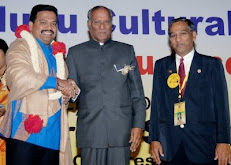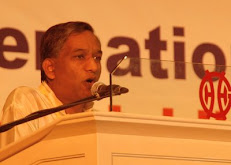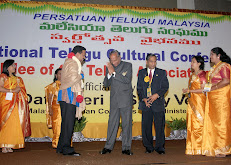
Sathya Sai Baba addresses his devotees in his native(mother tongue) language Telugu.
Sathya Sai Baba, born Sathyanarayana Raju on November 12, 1926 [1][2] with the family name of "Ratnakaram",[3] is a controversial South Indian guru, described by his followers as a godman and miracle worker.[1][4][5] The Sathya Sai Organization reports an estimated 1,200 Sathya Sai Baba Centers in 114 countries worldwide.[6] The number of Sathya Sai Baba adherents is estimated to be somewhere around 6 million, although followers cite anywhere from 50 to 100 million.[7] Followers consider him to be a reincarnation of the saint Sai Baba of Shirdi.
Sathyanarayana Raju was born to Peddavenkama Raju and Eswaramma in an agrarian family in the remote village of Puttaparthi, located in Anantapur district, Andhra Pradesh.[13] Biographer and devotee Schulman wrote in 1971 that "for any episode of Baba's childhood, there are countless contrasting versions and, at this point, the author discovered that it was no longer possible to separate the facts from the legend".
An official four-volume biography was written by devotee Professor Narayana Kasturi under the guidance of Sathya Sai Baba.The biography recounts an anecdotal incident where a cobra was found in the bedclothes of Sathya Sai Baba shortly after he was born.[16]. The book claims that the incident led to him becoming known as "lord of serpents" among the villagers.[2] Devotee Arnold Schulman contradicts the story, stating that Sathyanarayana Raju's sister who claims to have been present at his birth recounts the cobra was found outside of the house, several hours after Raju was born, a sight not uncommon in the village.[17] The young Sathyanarayana, the biography claims, was a vegetarian and was "known" for his aversion to animal cruelty.
At the age of eight, Satynanarayana Raju attended higher elementary school in Bukkapatnam. After that he joined another high school at Uravakonda. The biography claims that on March 8, 1940, Satynanarayana Raju started behaving "as if a scorpion had stung in his foot". He exhibited strange behavior after this and entered a coma state. After some time, he got up and his behavior worried his parents - he did not want to eat but, the biography claims, kept silent for a long time, and some times "recite verses". In May 1940, he proclaimed himself to be a reincarnation of the fakir and saint Sai Baba of Shirdi (d. 1918) and subsequently took the fakir's name, Sai Baba.[19] Baba purportedly taught them his bhajans (devotional songs that are sung out aloud in praise of minor Hindu deities or in praise of sai baba himself). Sai Baba claimed himself to be an "avatar". Sathya Sai Baba is listed in the 1942 school record of Bukkapatnam.[20] In 1944 a mandir for followers of Sathya Sai Baba was built near the village which is now called the "old mandir"(old temple).[18][21] The construction of Prashanthi Nilayam, the current ashram, was started in 1948.
In 1958, Sanathana Sarathi, the official magazine for the followers of Sathya Sai Baba, was published for the first time.
Sathya travelled only once outside India to visit North East Africa in 1968.[21]
Sathya Sai Baba had two sisters, one older brother (the late Seshama Raju) and a younger brother (the late R.V.Janaki Ramaiah).
Sathya Sai Baba established three temples (referred to as a "mandir") in India. The first center, established in Mumbai, is referred to as either "Dharmakshetra" or "Sathyam". The second center, established in Hyderabad, is referred to as "Shivam". The third center, established in Chennai, is referred to as "Sundaram".
Sathyanarayana Raju has been confined to a wheelchair since 2005 and reportedly his failing health has forced him to make fewer public appearances.
According to the Sathya Sai organization, Sathyanarayana Raju has written several articles on religious topics, later collected by the trust in the form of books, titled "Vahinis" (vehicles).[citation needed] There are sixteen vahinis.
Sai organization claims to advocate five values: sathya (truth), dharma (Hindu word for right conduct), ahimsa (non-violence), prema (love for God and all his creatures)[29] and shantih (peace).
Other teachings are:
Service and charity (seva) to others.[30]
Love for all creatures and objects.[30]
Putting a ceiling on one's desires is sadhana.[30]
Celibacy after age of fifty.[30]
Vegetarianism[29], moderate and sattvik diet.[30]
Abstinence from drinking alcohol,[30] smoking cigarettes,[30] and taking drugs.
Meditation (dhyan).[30] Baba teaches four techniques: repetition of the 'name of God'( "Sai" or "Sai Baba") ,[30] visualizing the form of God(often on sai baba's physical form),[30] sitting in silence, and jyoti (Flame/Light meditation).[30]
Importance of bhakti (devotion) to Sai Baba.[30]
Developing "prashanti"( vaguely translates to carefree-ness) and eschewing vices of character.[30]
Japa (ritual chanting of Baba's name) and other sadhana (spiritual exercise) to foster devotion.
Highly committed devotees use the phrase "Sai Ram" as a salutation.[30]
Conducting pooja or aarti( a form of ritual worship) twice daily in front of Baba photos.[citation needed]
At the ashram frequent "yagnas" or ritual worship involving ritual sacrifices of vegetable matter and ghee to a pyre is conducted for the baba.[30]
Ashrams and mandirs
The daily program at Sathya Sai Baba's temples usually begins with the chanting of "OM" and a morning prayer (Suprabatham). This is followed by Veda Parayan (chanting of the Vedas), nagarasankirtana (morning devotional songs) and twice a day bhajans and darshan (baba walks around or is wheel-chaired around amongst the gathered devotees) [52] Particularly significant are the darshans during October (the Dasara holidays and November (the month of Sai Baba's birth). [52] During darshan Sathya Sai Baba walks among his followers and may interact with people, accept letters, "materialize" and distribute vibhuti (sacred ash) or call groups or individuals for private interviews. Interviews are chosen solely at the Sai Baba's discretion.
Followers consider it a great privilege to get an interview and sometimes a single person, group or family will be invited for a private interview. It is claimed by the Sathya Sai Organization that meeting him has spiritual benefits.[53]
Some famous sayings of his are, "Help ever, Hurt never" and "Love all, Serve all'



.jpg)
.jpg)
.jpg)
.jpg)
.jpg)


No comments:
Post a Comment